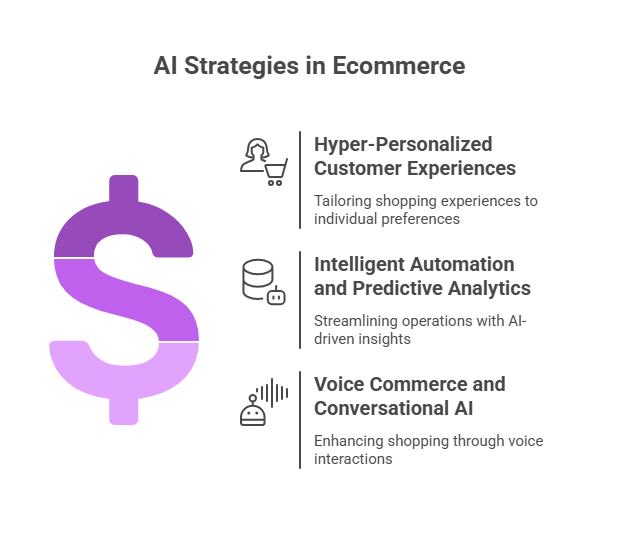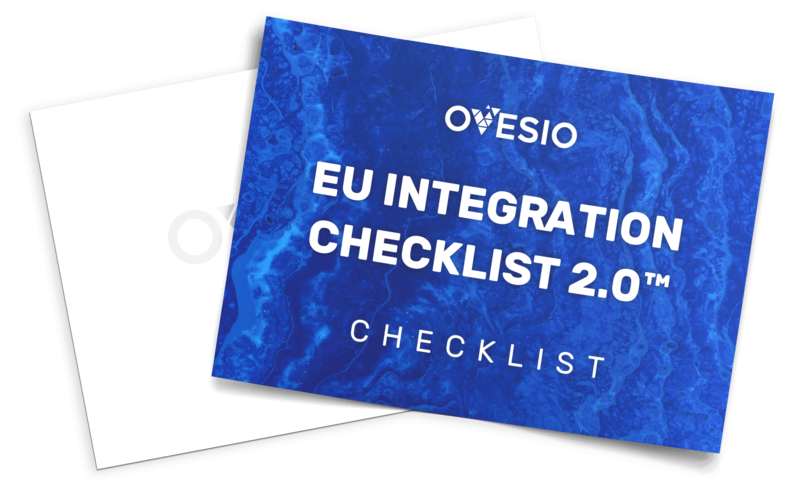3 Ecommerce AI Strategies That Will Make You Thrive

Ecommerce AI is more popular than ever, and that’s because of only one thing… it works like a charm, and it brings results.
Introduction
Artificial intelligence is no longer a futuristic concept, it’s the engine powering a HUGE shift in ecommerce.
From smarter shopping carts to predictive supply chains, AI is transforming how businesses engage customers and run operations.
With the global AI in ecommerce market valued at $8.65 billion in 2025 and projected to surge to $22.60 billion by 2032 at a robust CAGR of 14.6%, the future is unmistakably AI-driven.
It’s clear why 84% of ecommerce companies rank AI as a top priority for scaling their business.
Beyond hype, AI delivers real results, companies leveraging AI report a staggering 76% increase in operational efficiency alongside significant revenue gains.
Today, we will unpack three powerhouse AI strategies designed to help your ecommerce business not just survive, but thrive in this fast-evolving landscape.
Strategy 1: Hyper-Personalized Customer Experiences
Why Personalization Matters: From Luxury to Necessity
What was once a premium luxury, personalized shopping, is now a baseline expectation.
Today’s consumers demand experiences tailored precisely to their tastes, habits, and needs.
The brands that master this art don’t just capture attention; they command loyalty and drive sales repeatedly.
How AI Personalization Works in Ecommerce
Hyper-personalization uses AI’s muscle to analyze mountains of data and deliver exactly what each shopper wants, often before they even know it themselves.
Key techniques include:
- Real-time behavior analysis
AI tracks current browsing and clicks, instantly adapting recommendations to match shifting interests. - Collaborative filtering
Algorithms connect customers with similar preferences, suggesting products favored by like-minded shoppers. - Content-based filtering
Recommendations align with individual tastes by comparing product features with past purchases and preferences. - Predictive analytics
AI anticipates future needs, learning from historical data to forecast what customers are likely to want next.
Business Impact
The numbers tell the story: AI-driven recommendations can boost online sales by up to 15%, while companies leveraging personalization see an average of 44% repeat purchases and retain more than 56% of their customers. This isn’t just incremental improvement, it’s a transformation in how customers connect and convert.
Implementation Best Practices
Maximize AI’s power with these proven tactics:
- Quality data collection
Gather rich, accurate data from every customer interaction to fuel precise AI insights. - Dynamic, real-time recommendations
Deploy systems that adjust suggestions on the fly, responding to customer behavior as it happens. - Personalize the entire customer journey
Go beyond product picks, customize pricing, marketing messages, and content to amplify engagement. - Behavioral segmentation for micro-targeting
Use AI to create granular customer segments for sharply focused marketing campaigns that speak directly to individual preferences.
Looking To Integrate Your E-Commerce In Europe?
It can be extremely time-consuming and it will definitely give you tons of headaches if you’re not prepared.
I have something for you, and it’s 100% free.
The EU Integration Checklist 2.0 is a tool meant to help you integrate in your business in Europe much faster.
If you are not sure about selling in Europe, think about the fact that the E-Commerce Market in the US is worth only $8.3 Trillion, as of 2025, and that’s only 30% compared to the Global E-Commerce Market worth $28 Trillion.
In Europe, the E-Commerce Market is worth $6T, projected to reach $18.8 Trillion in a short period of time, by 2033.
Take your time!
Click the image below for the link 👇
Strategy 2: Intelligent Automation and Predictive Analytics for Operations
Ecommerce operations are complex and fast-paced, but AI is revolutionizing the way businesses manage inventory, forecast demand, detect fraud, and deliver customer service.
Operational Challenges AI Solves
AI tackles some of the biggest pain points in ecommerce operations:
- Inventory management , avoiding costly stockouts or excess inventory
- Demand forecasting , predicting what, when, and how much customers will buy
- Fraud detection , catching suspicious activity before it costs you
- Customer service automation , providing fast, reliable support around the clock
Predictive Analytics Applications
Predictive analytics turns data into foresight, enabling smarter, proactive decisions:
- Demand Forecasting
AI analyzes past sales trends, seasonality, and external factors to predict demand with remarkable accuracy, optimizing stock levels and reducing waste (according to McKinsey). - Customer Behavior Prediction
AI models identify customers at risk of churning, estimate lifetime value, and pinpoint the best moments for targeted marketing, boosting retention and loyalty (Forbes). - Dynamic Pricing Optimization
By adjusting prices in real-time based on market demand, competitor pricing, and inventory, businesses report up to 8% revenue growth while staying competitive (Accenture).
Intelligent Inventory Management
AI makes inventory smarter with:
- Automated demand forecasting and reorder processes that react instantly to changing market conditions
- Real-time tracking powered by IoT for full visibility across the supply chain (Gartner)
- Supply chain optimization to cut costs and speed delivery
Customer Service Automation via AI Chatbots
AI chatbots deliver:
- 24/7 support without increasing headcount
- Instant responses that delight customers with speedy answers
- Human-like conversations using advanced Natural Language Processing (NLP), improving engagement (Statista)
Fraud Detection & Security
AI elevates ecommerce security through:
- Real-time transaction monitoring to catch fraud as it happens
- Pattern recognition that spots suspicious behavior with up to 95% accuracy (IBM)
- Reduced false positives, protecting legitimate customers without unnecessary interruptions
Strategy 3: Voice Commerce and Conversational AI in Ecommerce
Voice is reshaping ecommerce, making shopping hands-free, intuitive, and faster.
With 37% of global shoppers already buying via voice (OC&C Strategy Consultants]), this trend is accelerating, especially alongside social commerce.
Key AI Technologies Behind Voice Commerce
- Speech Recognition
Converts spoken commands into text, enabling users to search and shop with their voice. - Natural Language Processing (NLP)
Understands context and intent, allowing AI to carry on fluid, human-like conversations. - Machine Learning Personalization
Learns from each interaction to tailor recommendations and streamline the shopping experience. - Voice Authentication
Uses unique biometric patterns for secure, personalized access.
Business Benefits
Voice commerce delivers:
- Seamless, hands-free shopping that fits into busy lifestyles (PwC)
- Faster purchase completion, with shoppers completing orders 47% quicker when assisted by voice AI (Capgemini)
- Enhanced personalization through continuous learning from voice interactions
Deployment Tips
To harness voice commerce effectively:
- Optimize your product database for accurate voice search results
- Implement conversational AI capable of handling complex, multi-step dialogues
- Design natural, intuitive voice interactions that feel human and effortless
- Integrate voice systems with CRM, inventory, and fulfillment platforms to ensure smooth end-to-end experiences
Future Outlook
Industry experts predict that by 2030, 70% of consumers expect to shop primarily through social media, bypassing traditional websites entirely (OC&C Strategy Consultants).
Voice commerce will be a critical driver, with 7 in 10 shoppers wanting AI-driven tools, including voice search, to guide their buying decisions.
Key Success Factors for Implementing AI in Ecommerce
Data Quality & Management
Successful AI starts with high-quality data. Ensure your data is:
- Comprehensive , collected from all customer touchpoints
- Clean , free from errors and inconsistencies
- Privacy-compliant , following regulations like GDPR and CCPA
- Unified , integrated across systems for a complete customer view
Phased Approach
Adopt a step-by-step implementation strategy to minimize risk and maximize impact:
- Start small with one AI solution
- Prove ROI early to build confidence
- Scale gradually to more complex applications
- Build internal expertise over time
Customer-Centric Focus
Keep the customer at the heart of every AI effort:
- Solve real pain points that improve their experience
- Maintain transparency about AI usage and data collection
- Preserve the human touch for nuanced interactions
- Continuously gather feedback and refine AI applications

Conclusion
AI integration is no longer optional, it’s essential for ecommerce businesses aiming to survive and thrive in a competitive digital marketplace.
By embracing the three key strategies, hyper-personalized experiences, intelligent automation with predictive analytics, and voice commerce, companies can unlock remarkable results, including up to 4X higher conversion rates, 25-30% revenue growth, and 76% operational efficiency gains.
If you’re looking to learn more about AI in Ecommerce, here’s an article for you: What Are the Best AI Tools for Ecommerce in 2025? (Top 5)






